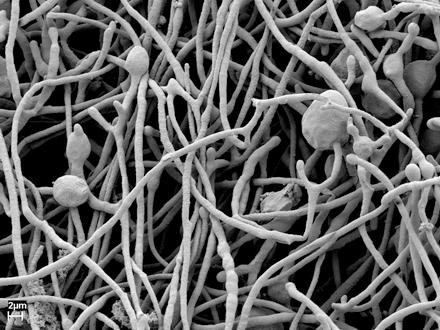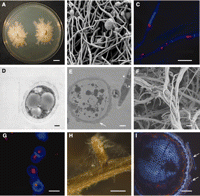![]()
Arqueorizomicetos: Una Nueva Clase de Hongos del Suelo (pero muy común) Identificada y Clasificada por Primera Vez
El título de la noticia parece contradictorio, pero no lo es. Descubrir una nueva “clase” que no especies, géneros, familias, se considera un gran hallazgo taxonómico. ¿Y como se sabía que su presencia era tan frecuente?. ¡Sencillo!. Las muestras de DNA de muchas muestras de suelo analizadas previamente contenían secuencias de sus nucleótidos que han logrado asociarse a este hongo que solo esporula (desprende las esporas) en el interior del suelo. Como su denominación indica, debe tratarse de una clase que muestra caracteres muy antiguos (“arqueo”). Su detección se realizó cuando se analizaban las micorrizas de ciertas coníferas, lo cual no significa que hasta la fecha se tenga constancia de sus hábitos alimentarios y ecológicos. Los autores detectaron mediante microscopía que era una forma extraña, filamentosa, no conocida por la ciencia y luego (…) Su aislamiento, permitió cultivarlo in vitro, constatándose que se se trataba de un organismo de crecimiento lento que puede “criarse” en medios de cultivo a base glucosa y celulosa. Todo apunta a que estamos ante un hongo común, asociado a la descomposición de los restos vegetales. Tal descubrimiento ha sido publicado en la revista Science. Ahora deberá analizarse su papel en el medio edáfico, así como investigar si se trata de una clase monoespecífica, o atesora varias especies, géneros, familias, órdenes, etc. Ya os hemos comentado que, conforme avance la bioprospección del suelo, con toda seguridad, la ciencia se llevaré enormes sorpresas. El problema estriba tanto en la incomprensible falta de interés por estudiar la biología del suelo, como por su dificultad, ya que es un medio poroso y heterogéneo, pero también opaco. Entiendo que a los científicos que han llevado a cabo el estudio les ha sonreído la diosa fortuna, por cuanto los expertos reconocen que el problema para detectar muchas formas de vida edáfica estriba en que no crecen en los medios de cultivo convencionales, por lo que resulta muy difícil detectar y catalogar la biodiversidad del suelo. Pura serendipia (analizaban micorrizas), pero así se encuentran muchas nuevas formas de vida. Abajo os incluyo la nota de prensa de Sciencedaily. Posiblemente lo hemos pisado en numerosas ocasiones, adhiriéndose a los zapatos de numerosísimos ciudadanos que paseaban, o trabajaban en el campo.
Juan José Ibáñez

Archaeorhizomycetes. Fuente: expertsvar
Hidden Soil Fungus, Now Revealed, Is in a Class All Its Own
ScienceDaily (Aug. 11, 2011) — A type of fungus that’s been lurking underground for millions of years, previously known to science only through its DNA, has been cultured, photographed, named and assigned a place on the tree of life.
Researchers say it represents an entirely new class of fungi: the Archaeorhizomycetes. Like the discovery of a weird type of aquatic fungus that made headlines a few months ago, this finding offers a glimpse at the rich diversity of microorganisms that share our world but remain hidden from view.
The fungal phenomenon, brought to light by researchers at the University of Michigan, the Swedish University of Agricultural Sciences, the Imperial College London and Royal Botanic Gardens and the University of Aberdeen, is described in the Aug. 12 issue of the journal Science.

Arequeorizomicetos. Fuente: Science
Although unseen until recently, the fungus was known to be extremely common in soil. Its presence was detected in studies of environmental DNA — genetic material from a living organism that is detected in bulk environmental samples, such as samples of the soil or water in which the organism lives.
«You couldn’t really sample the soil without finding evidence of it,» said Timothy James, a U-M assistant professor of ecology and evolutionary biology and an assistant curator at the university’s herbarium. «So people really wanted to know what it looks like.»
That became possible thanks to the work of the Swedish researchers, led by mycologist Anna Rosling. The researchers were studying mycorrhizae — fungi that colonize plant roots — when they discovered that some root tips harbored not only the mycorrhizae they were interested in, but also an unfamiliar fungus.
«When culturing mycorrhizal fungi from coniferous roots we were exited to find that one of the cultures represented this unfamiliar fungus,» said Anna Rosling.
Later the culture was identified as a member of Soil Clone Group 1 (SCG1), a ubiquitous but enigmatic lineage known only from environmental DNA. It’s not especially impressive to look at, James concedes: «It doesn’t make some crazy structure that nobody’s ever seen.» But simply seeing and photographing a form of life that’s been invisible until now is cause for excitement.
Having in hand a member of the elusive fungal group, the Swedish scientists and their collaborators have been able to study the group in more detail than ever before possible, using electron microscopy, DNA sequencing and in vitro growth studies to characterize it. The fungus they cultured is a slow-growing form that produces none of the typical aerial or aquatically dispersed spores most fungi typically reproduce with, suggesting it seldom if ever sees the light of day.
«By finding that it is slow growing and only produces spores in the soil, we can provide an explanation for why it has taken so long to be cultured,» James said. The researchers also performed experiments aimed at understanding how the fungus, dubbed Archaeorhizomyces finlayi, interacts with the environment and with other organisms.
«We don’t have any evidence that it’s pathogenic; we don’t have any evidence that it’s mutualistic and doing anything beneficial for the plant,» James said. «It’s a little bit of a boring fungus.» It may, however, help break down and recycle dead plants, a common — and extremely important — job for fungi. Hints of this role come from the observation that A. finlayi grows in the lab if provided with food in the form of glucose or cellulose (the main structural component of plant cell walls).
«Because it is so common in the soil, it must be very successful at what it does, and that role must be ecologically relevant,» Rosling said.
Now that the researchers have ruled out some typical fungal roles — such as pathogen, benign endophyte, and member of a mycorrhizal association — they hope to find out through additional experiments exactly what role the fungus does play in nature and how it interacts with plants and other fungi.
«At this point we’re still in the early stages of understanding what it’s doing out there,» James said.
Whether A. finlayi turns out to be beneficial or detrimental to the plants or microbes it interacts with, it’s sure to contribute to understanding the diverse array of fungi in the world.
Though environmental DNA of SCG1 had been collected and reported in more than 50 previous studies, the type of DNA collected in the past didn’t lend itself to analyses that would definitively pinpoint the group’s position on the tree of life.
«Now that we have the culture, we can sequence almost any gene we want, so that’s what we’ve done,» James said.
The resulting information, combined with DNA data from the previous studies, revealed that A. finlayi belongs in an eclectic subphylum known as Taphrinomycotina, other members of which include the yeast Schizosaccharomyces, often used in studies of cell biology and evolution, and Pneumocystis, which can cause pneumonia in people with weakened immune systems, such as those who have cancer or HIV/AIDS or are undergoing treatment with immune-suppressing drugs.
In addition to James and Rosling, who is currently a visiting research associate at Indiana University, the paper’s authors include Filipa Cox of the Imperial College London and Royal Botanic Gardens; Karelyn Cruz-Martinez, Katarina Ihrmark, Björn Lindahl and Audrius Menkis of the Swedish University of Agricultural Sciences; and Gwen-Aëlle Grelet of the University of Aberdeen.
The research was funded by the Carl Trygger Foundation, The Swedish Research Council Formas and the National Environment Research Council (UK).
Story Source: The above story is reprinted (with editorial adaptations by ScienceDaily staff) from materials provided by University of Michigan.
Journal Reference: A. Rosling, F. Cox, K. Cruz-Martinez, K. Ihrmark, G.-A. Grelet, B. D. Lindahl, A. Menkis, T. Y. James. Archaeorhizomycetes: Unearthing an Ancient Class of Ubiquitous Soil Fungi. Science, 2011; 333 (6044): 876 DOI: 10.1126/science.1206958

[…] El título de la noticia parece contradictorio, pero no lo es. Descubrir una nueva “clase” que no especies, géneros, familias, se considera un gran hallazgo taxonómico. ¿Y como se sabía que su presencia era tan frecuente?. ¡Sencillo!. Las muestras de DNA de muchas muestras de suelo analizadas previamente contenían secuencias de sus nucleótidos que han logrado asociarse a este hongo que solo esporula (desprende las esporas) en el interior del suelo. Como su denominación indica, debe tratarse de una clase que muestra caracteres muy antiguos (“arqueo”). Su detección se realizó cuando se analizaban las micorrizas de ciertas coníferas, lo cual no significa que hasta la fecha se tenga constancia de sus hábitos alimentarios y ecológicos. Los autores detectaron mediante microscopía que era una forma extraña, filamentosa, no conocida por la ciencia y luego (…) Su aislamiento, permitió cultivarlo in vitro, constatándose que se se trataba de un organismo de … [Seguir leyendo…] Compromiso social por la ciencia Master Site Feed Posts […]
[…] Arqueorizomicetos: una nueva clase de hongos del suelo identificada y clasificada por primera vez http://www.madrimasd.org/blogs/universo/2011/08/16/140153 por hugamen hace 2 segundos […]
[…] de que su rastro de DNA constataba que eran bastante ubicuos en el medio edáfico. Hablamos de los arqueorizomicetos. Si se tratara de una especie endémica de aquella región entonces (…) cabría replantearse de […]